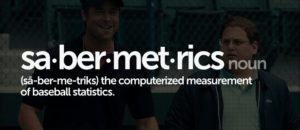Physical Therapy “Sabermetrics”
Ever since the book “Moneyball” was published that talked about how Billy Beane of the Oakland A’s analyzed data in baseball, the statistics geeks now are looking at tons of different numbers to analyze baseball player potential and performance. Mr. Beane was immortalized for his methods of evaluating talent and being able to get it at basement price levels (that’s what it’s about, more or less). The story was even on the big screen where Brad Pitt played Mr. Beane. Baseball really has the market cornered on sabermetrics. It’s fair to say that no other sport analyzes numbers and data more than baseball. So let’s have some fun with this post and talk about what sabermetrics might look like for physical therapist performance.

Evaluating Physical Therapist Talent via “Sabermetrics”
“5 Tool Player” – in baseball, the “5 Tools” that make a great baseball player for non-pitchers are hitting for average, hitting for power (home runs), speed, base-running skills, throwing ability, and fielding ability. In physical therapy, a super-star “5 Tool PT” has the knowledge, personality, communication skills, passion, and critical thinking skills.
RBI – Runs Batted In for baseball. In physical therapy, “Referrals Brought In.” RBI’s are measured by how many patients come in per month as a direct result of a particular physical therapist performance. RBI’s are calculated by how many patients come in either from a direct request of that patient or from a physician office multiplied by how many visits they have as a result.
ERA – Earned Run Average for baseball. In physical therapy, “Earned Referral Average.” ERA is calculated by dividing the RBI’s by the total visits the physical therapist saw that month.
OBP – On-Base Percentage in baseball. In physical therapy, this is “Outcomes –to-Bottom Line Percentage.” We need some integrity in how we practice. You want a PT to be productive with their time and bill appropriately. You want them to get fantastic outcomes too. You really don’t want (or shouldn’t want) a PT to milk visits dry either just to keep their schedule full. Ideally, you have fantastic outcomes AND you maximize the patient’s visit needs. So, if you have a patient who’s LEFS is 80/80 and your PT did that in 6 visits, their OBP will be higher than someone who had a poorer outcome and took longer to do so.
SP – Slugging Percentage in baseball. In physical therapy, this is “Staff Percentage.” This is basically calculated by taking the total staff and how many people actually like that person. So, if you’re kind of a tool, your SP will be really low, but if you’re a really swell guy/gal, your SP will be awesome.
OPS – On-Base Plus Slugging for baseball. In physical therapy, “Outcomes Plus Satisfaction.” Whatever method by which you measure outcomes in your facility, take that number as a percentage (so if Lower Extremity Functional Scale averages 76/80, your score would be 95) and add that to the satisfaction survey scores. An outstanding PT will have really high numbers because they’ll have great outcomes AND happy patients. People may like their outcome, but not care for their PT or the experience they had so their OPS will definitely be lower. To have a high OPS, you have to have the one-two punch of clinical acumen and unparalleled people skills.
HR – Home Runs in baseball. In physical therapy, “Happy Referrals.” As balls leave the yard in baseball, HR numbers escalate. Well, as patients leave and they’re ecstatic, so too does a PT’s HR total.
WAR – Wins Above Replacement in baseball. Basically, this statistic is “all-encompassing” for baseball. It tells the stats folks how valuable they are to their team in one single value. So, if a superstar player’s WAR is 5 and their Triple-A replacement player is 1, it’s clear that the superstar is a huge asset to their team. In physical therapy, WAR is actually “Work Above Replacement.” Essentially, a productive, solid physical therapist brings bodies into the clinic. Patients tell their friends and doctors recommend them by name. Plus, a great staff PT is enjoyable to work with and helps create an experience at the clinic that keeps the place poppin’. If this person leaves and is replaced with someone that maybe isn’t as strong or as experienced and may not light the world on fire with their personality, the WAR will be less for that PT. You have to be a skilled clinician and an enjoyable person to be around first, as well as a great advocate for the profession and the facility.

Hopefully after “PT Sabermetrics,” you have a staff full of people with just insane, Hall-of-Fame numbers that are consistent over the years. It should help evaluate talent, and maybe even find a sensational PT that maybe graduated last in their class but has all the “tools” to be a superstar. On the contrary, we hope you don’t overpay for some entitled prima donna that thinks they’ll be amazing just because of their GPA and degree from a “top notch” institution! Gotta have the people skills too! Thanks for reading.
Tags: physical therapist, Physical Therapy, sabermetrics, SSOR
